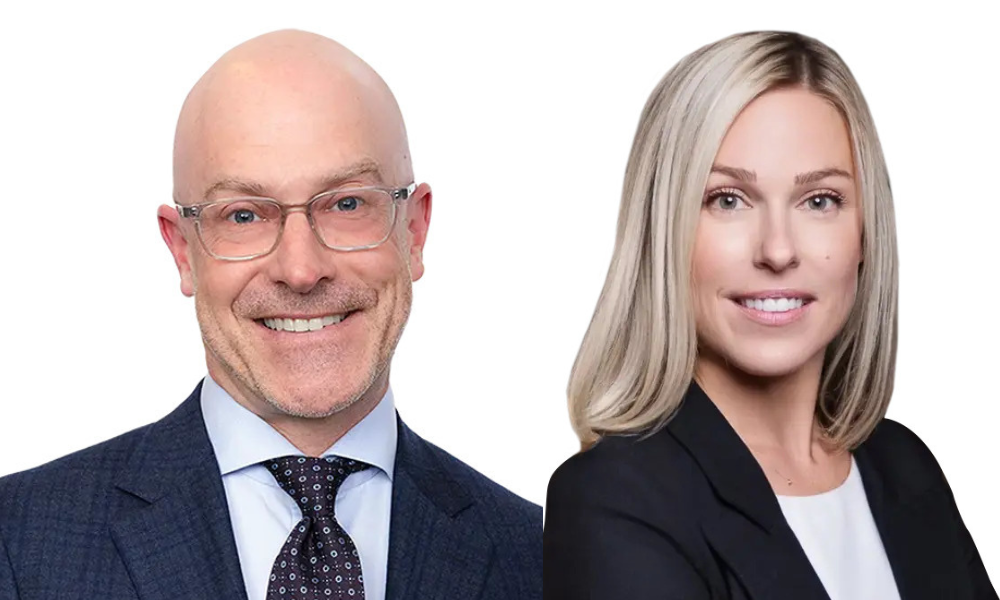
New partners at Gowling explain how tariffs, fraud, and soaring costs are changing IP protection for luxury brands

Gowling WLG has expanded its intellectual property group with the addition of Shane Hardy and Brigeeta Richdale, who join as partners from a Canadian branch of the US-based law firm Cozen O’Connor.
Hardy and Richdale say the moves were driven by Gowling’s global platform, deep bench of IP professionals, and in-house legal tools.
“We want to make sure that we're doing exactly what our clients want us to do, and in the jurisdictions in which they can do it,” Hardy says.
Hardy says Canadian businesses are increasingly looking beyond their traditional trading partners, with clients showing strong interest in expanding into markets such as the UK, France, Germany, the Middle East, and China.
He sees this as a sign that the Canadian economy is maturing but also points to concerns arising from changing circumstances in trade with the US.
While the US remains a dominant market, Hardy says companies actively seek to diversify, regardless of how the tariff standoff plays out.
“Different measures and different tariff concepts are going to come, and they are going to go, and that's fine. Clients will learn how to deal with those.”
On the other hand, he adds, clients increasingly recognize and appreciate the opportunities beyond the US.
“There are consumers across continents on whom they haven’t necessarily focused in the past.”
Richdale says one of Gowling’s strongest appeals was its robust suite of legal technology tools. Among them is an in-house anti-counterfeiting software platform that allows the firm to monitor and disrupt counterfeit operations in real time.
“Instead of reacting to alerts, it enables us to actively monitor and eliminate threats to our clients’ brands,” she says.
The pair’s practice is focused on brand management, spanning transactional, advisory, and dispute-resolution work. While experienced across patents, trademarks, copyrights, and industrial designs, Hardy says the team’s core priority is brand strategy and enforcement.
“Most clients don’t want to be in disputes – they detract from their bottom line and make them pay attention to things outside of their core business opportunities.”
Hardy and Richdale – based in Toronto and Vancouver, respectively – bring a shared book of business and operate as a team.
“Our clients are following. There have been no conflict issues. We get a larger services offering, so we certainly don’t anticipate a drop-off,” Hardy says.
Hardy says that both counterfeiters and legitimate businesses are pushing the limits of intellectual property law with increasing boldness. Counterfeit operations have become more aggressive, while brand creators are edging closer to potential infringement as they struggle with limited vocabulary and imagery options for product naming. Canadian Lawyer has recently reported on the growing boldness and sophistication of trademark fraudsters.
“Legitimate businesses are also pushing the envelope,” he says.
Emerging technologies have only added to the complexity.
While AI-assisted trademark searches are well-established, brand creation through AI brings new legal questions around originality, authorship, and potential IP infringement.
“It’s not replacing our work – it’s giving lawyers and clients even more to think about,” Hardy says.
Richdale says luxury brands are taking a more vigilant approach to protecting their brands amid fraud threats and the rise of digital commerce. She adds that the balance between maintaining the in-person experience of luxury and enabling online access is becoming increasingly difficult to manage.
“Brands are trying to reassure artists and protect the integrity of their ideas while also running a global business.”
She says a significant trend is that clients reach out earlier in product development, not just when issues arise. While more labour-intensive, that work model yielded the best results for her and Hardy.
“We’re present on factory floors, in our clients’ offices, and face-to-face around the world. That proximity allows us to give better advice earlier.”
As the cost of goods rises, Hardy warns that more consumers may turn to the black market – a concern particularly relevant for luxury brands.
Their team closely monitors the relationship between tariffs, the cost of goods, and counterfeits.
He adds that counterfeit goods falsely claiming legitimacy – often manufactured overseas – are surfacing more frequently and catching clients off guard.
“The speed at which this has developed is virtually unparalleled,” Hardy says, adding that the law struggles to keep pace with evolving business practices.
To counter this, he says his team is helping clients tighten their contractual relationships with overseas manufacturers, especially in jurisdictions with weaker IP protections.
He says the clients must move beyond handshake deals and put clear expectations and legal safeguards in writing.